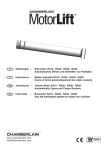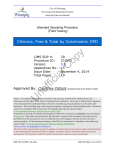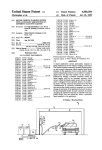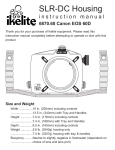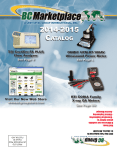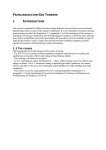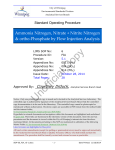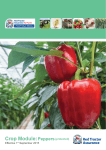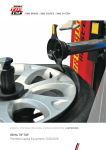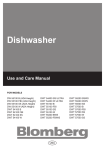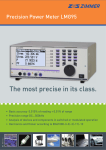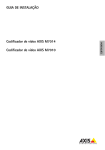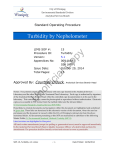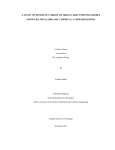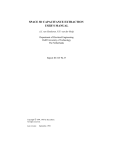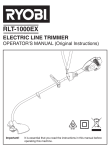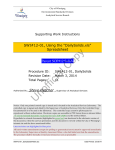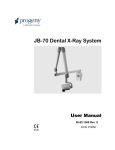Download Solids (TSS, TVSS, TDS, TS, TVS)
Transcript
City of Winnipeg Environmental Standards Division Analytical Services Branch Standard Operating Procedure Solids 12 Solids 5.1 008 (ASB) 023 (WTP) October 20, 2014 21 U no ffi c ia lC LIMS SOP #: Procedure ID: Version: Appendices No: Appendices No: Issue Date: Total Pages: op y Total Solids (TS) Total Suspended Solids (TSS) Total Volatile Suspended Solids (TVSS) Total Volatile Solids (TVS) Total Dissolved Solids (TDS) Moisture (%H2O) Authorized By: Courtney Diduck, Analytical Services Branch Head Notice: Two printed control copies are issued, with one copy located in the Analytical Services Branch Laboratory and the other at the Water Treatment Plant Laboratory. Each copy is authorized by signature of the Analytical Services Branch Head. Only the controlled copy documentation is to be used in the laboratory. This controlled copy cannot be photocopied or reproduced without authorization. Electronic copies are accessible in PDF format from the method folder and the intranet folder; N:\Environmental Standards\Analytical Services\SOP (PDFs) Hyperlinks to external documents and within this document are highlighted and underlined in green font. These are functional in the electronic version of this document, when the user has permission and the document is viewed within the City of Winnipeg’s intranet site from the above mentioned folder. All documents pertaining to this SOP are maintained in subfolders of the following Master Folder; N:\Environmental Standards \Methods\Solids (SOP 12) Latest revisions are highlighted in blue print. All hand-written amendments (except for spelling or grammatical errors) must be approved immediately by the Analytical Services Branch Head or Quality Assurance Officer, who shall initial and date the amendments. The procedure shall be formally revised and reissued as soon as practicable. SOP-12_Solids_v5-1.docx Date Printed: 10/22/2014 Accredited Test Method Analytical Services Branch Environmental Standards Division Method Name: SOP#12, Solids v5.1 Method Date: October 20, 2014 Page 2 of 21 Table of Contents All forms, reagent logs are located in; N:\Environmental Standards\Methods\Solids (SOP 12)\FORMS\SolidsForms.xlsx Control Charts: N:\Environmental Standards\Analytical Services \Charts\ChartGenerator.xls Table of Contents .......................................................................................................... 2 Introduction and Scope ................................................................................................... 3 Summary of Method ....................................................................................................... 4 Sample Requirements .................................................................................................... 4 Chemicals & Reagents ................................................................................................... 5 y Reagent Preparation Logs .................................................................................................. 5 Expiry Dates .................................................................................................................. 5 Diatomaceous Earth Pre-preparation (for HRM) ........................................................................ 5 TSS HRM, 100 mg/L (& 1,000 mg/L) ...................................................................................... 6 TS-TDS HRM, 700 mg Total Solids or Total Dissolved Solids/L ..................................................... 6 Certified Reference Material (peCheck Solids) .......................................................................... 6 U no ffi c ia lC op Equipment & Supplies .................................................................................................... 7 Instruments ............................................................................................................................................. 7 Bar-coded, Pre-weighed Filters .............................................................................................................. 8 Glassware Preparation ................................................................................................... 8 Gooche Preparation for Prewashed Filters (Part No:F92432VOL) ........................................................ 8 Gooche/Filter Preparation ...................................................................................................................... 9 Crucible preparation ............................................................................................................................... 9 Quality Control Plan ..................................................................................................... 10 Daily Balance Check............................................................................................................................. 10 Batch Creation ...................................................................................................................................... 10 Method Quality Control ......................................................................................................................... 10 Acceptance Criteria .............................................................................................................................. 11 Non-Conformance and Corrective Action ............................................................................................. 11 Proficiency Testing ............................................................................................................................... 11 Test Procedure ........................................................................................................... 12 Taking Aliquots (sub-samples) ............................................................................................................. 12 Solids Methods ..................................................................................................................................... 12 Total Suspended Solids ........................................................................................................................ 13 Total Volatile Suspended Solids ........................................................................................................... 14 Volatile Solids (following the TS) .......................................................................................................... 16 Volatile Solids, direct method for liquids ............................................................................................... 16 Total Dissolved Solids .......................................................................................................................... 17 Data Analysis & Calculations .......................................................................................... 18 Safety ...................................................................................................................... 19 Revision History ......................................................................................................... 19 Document Control ....................................................................................................... 20 Appendices ............................................................................................................... 20 Tab 1: Control Charts ......................................................................................................20 Tab 2: Reagent Preparation Logs & Certificates ......................................................................20 Tab 3: Worksheets ..........................................................................................................20 Tab 4: DailySolids.xls Spreadsheets (Instruction Manual) ...........................................................20 Tab 5: Method Validation ..................................................................................................20 Tab 6: Daily Balance Calibration Checks................................................................................20 References ............................................................................................................... 20 Supporting Test Methods ..................................................................................................20 Equipment Instruction Manuals ...........................................................................................21 Computer Software Documentation ......................................................................................21 Endnotes (file and folder locations) ...................................................................................................... 21 SOP-12_Solids_v5-1.docx -2- Date Printed: 10/22/2014 Accredited Test Method Analytical Services Branch Environmental Standards Division Method Name: SOP#12, Solids v5.1 Method Date: October 20, 2014 Page 3 of 21 Introduction and Scope The measurement of solids content of water and wastewater is important for regulatory purposes and environmental protection. The solids content in the different wastewater streams is a measure of the wastewater treatment plant efficiency, and solids loading. The solids content is also used to determine the wastewater surcharge for industrial and septic waste generators. Referenced Method This method is modified from Standard Methods for the Examination of Water and Wastewater, 2540 Solidsi, approved by Standard Methods Committee 1997, Editorial Revisions 2011, with the following modifications; Samples are not weighed to constant weight. Instead, a much longer drying time is used for TDS & TS and a reweighed sample is included in each batch. If the reweigh is outside the established quality control limits, then the batch is dried for an additional 30 minutes and desiccated again. Sludge and samples with high solids or grease content are dried overnight (>12 hrs). For Total Dissolved Solids, some samples (such as Industrial wastes and leachates) cannot be filtered due to their extremely high content of particulate matter that immediately clog the filter. For these samples only, the sample is centrifuged at 4000 rpm for 20 minutes and the centrate is used for TDS. Scope TVSS TDS TS %TVS ia TSS lC op y 3 to 20,000 mg/L 3 to 20,000 mg/L 3 to 20,000 mg/L 3 to 20,000 mg/L 0.03 to 40% 0.03 to 100% Minimum Detectable Limits 3 mg/L 3 mg/L 3 mg/L 3 mg/L 3 mg/L Accuracy U no ffi c Applicable Range for routine water, wastewater, and sludge Bias (relative) -0.017 -0.017 -0.002 0.003 0.003 Precision 0.039 0.043 0.025 0.055 0.01 0.084 0.087 0.065 0.062 0.029 Expanded Uncertainty, Ue *percentage range applies to sludge and biosolids analysis. Fit For Use This method is fit for its intended use for the determination of: o Total Suspended Solids, Total Volatile Suspended Solids, and Total Dissolved Solids in the range of 3 mg/L to 20,000 mg/L in water and wastewater; o Total Volatile Solids in the range of 0.03% to 100% in sludge and biosolids. o Total Solids, in the range of 3 mg/L to 20,000 mg/L in water and wastewater; and the range of 0.03% to 40% in sludge and biosolids. Method Validationii By G. Levesque, QA Officer, Date: October 23, 2009. Last validation update by G. Levesque, QA Officer, Date: October 31, 2013. SOP-12_Solids_v5-1.docx -3- Date Printed: 10/22/2014 Accredited Test Method Analytical Services Branch Environmental Standards Division Method Name: SOP#12, Solids v5.1 Method Date: October 20, 2014 Page 4 of 21 Summary of Method Total suspended solids are determined by filtering a well-mixed measured volume of sample through a weighed standard glass fibre filter in a gooche crucible. The residue retained on the filter is dried at 104C ± 1 to a constant weight. The increase in weight of the filter and gooche represents the total suspended solids. The filtrate from the total suspended solids can be used to determine the Total Dissolved Solids. Volatile suspended solids are determined by igniting the residue from the total suspended solids analysis in a muffle oven at 550oC. Total solids are determined by adding a known volume of a well-mixed sample into a weighed crucible, and after heating to dryness is dried to a constant weight. Moisture is the loss of weight due to evaporation when dried. Volatile Solids is the weight loss after ignition of the total solids residue at 550 oC. op y When total solids and total suspended solids are determined on the same sample, total dissolved solids can be determined by calculation. LIMS Test Codes Total Suspended Solids weight per volume (mg/L) TVSSwv Total Volatile Suspended Solids weight per volume (mg/L) TVSS% Total Volatile Suspended Solids % TSwv Total Solids weight per volume (mg/L) TS% Total Solids % TVS% Total Volatile Solids % TDSwv Total Dissolved Solids weight per volume (mg/L) %Moisture Moisture, the amount of water in the sample (calculated from Total Solids) U no ffi c ia lC TSSwv Sample Requirements Sample History Some samples are collected by internal clients and submitted/delivered directly to the laboratory. Routine samples are collected by laboratory personnel assigned to the task following SOP#17, Sampling.iii Field or Laboratory Filtration Not required Preservation If the test is not performed within 2 hours of sample reception at the laboratory, the sample must be stored at 4C ±2C. Holding Time Analysis is normally performed within 24 hours of sample collection. Refrigerated samples can be held for no longer than seven (7) days. Sample Pre-treatment SOP-12_Solids_v5-1.docx -4- Date Printed: 10/22/2014 Accredited Test Method Analytical Services Branch Environmental Standards Division Method Name: SOP#12, Solids v5.1 Method Date: October 20, 2014 Page 5 of 21 Large non-homogenous particles should be excluded from the test aliquot if it is determined that their inclusion is not desired in the final results. Floating oil and grease, if present, should be included in the sample and dispersed by vigorous stirring 5 times to create a vortex before withdrawing a sub-sample for filtration. Floating debris (excluding oil & grease) is excluded. Allow samples to warm to room temperature before analysis. Containers Samples should be collected in a plastic or glass bottle and transported to the laboratory as soon as possible for analysis. op y Volume Required Excessive residue on the filter can produce a water trapping crust, which can result in sample loss, or incomplete drying. The sample size should be limited to produce a residue of less than 200 mg. Samples containing visible suspended solids require less volume for analysis. For water samples containing little or no visible suspended solids a greater sample volume may be required for analysis. Collect a minimum of 500 mL for turbid samples and 1 litre for water samples. Interferences lC Samples with high dissolved solids may cause positive interferences. These effects can be minimized with adequate washing to remove dissolved solids, which may get trapped in the filter pores. ffi c ia Filter clogging, from excessive solids captured in the filter, may prolong filtration time and produce high results. To overcome this, use a smaller sample volume for filtration, or use a larger size filter. U no Chemicals & Reagents Reagent Preparation Logs Document the preparation of all reagents; calibration stock solutions, reference material stock solutions, and working standards on the reagent preparation log sheets behind Tab 3. Label reagents with; Material Name, Date Prepared, and Reagent Prep Log Reference Number or LIMS ID #. All Reagent preparation forms are available in SolidsForms.xlsxiv All Certified Reference Materials are entered into the LIMS, Chemicals and Standards Module and a copy of in the COA is scanned (downloaded) into the COA folder v. De-ionized/R.O. Water; is used when making any reagent unless otherwise stated. Expiry Dates Unless specified, all reagents in solid form have an expiry date of 5 years when unopened and 3 years from the date opened. Purchased reagents in liquid form have an expiry date of 3 years unopened and 12 months opened. All prepared reagents are considered “opened” on the date made and therefore never exceed 12 months. If the vendors’ expiry date is less than these default dates, then use the vendors, i.e., always use the shortest date. Diatomaceous Earth Pre-preparation (for HRM) The diatomaceous earth is prepared in the following manner to remove the finest particles which may not get trapped in the glass filter paper. SOP-12_Solids_v5-1.docx -5- Date Printed: 10/22/2014 Accredited Test Method Analytical Services Branch Environmental Standards Division Method Name: SOP#12, Solids v5.1 Method Date: October 20, 2014 Page 6 of 21 1. Prepare the Diatomaceous Earth by placing approximately 50 grams into a 2-liter beaker. 2. Add 2 litres of deionised water, stirring vigorously for 5 minutes. 3. Allow settling for 30 minutes. 4. Decant all of the liquid. Transfer the solid into a smaller beaker and dry overnight at 104 ±1oC. 5. Remove from oven, cool for 15-20 minutes at room temperature, then transfer into desiccators until room temperature is reached. Transfer to a clean plastic wide-mouth bottle and label. Store in the desiccator. Diatomaceous Earth does not expire. 6. Pre-weigh several standards ahead of time into separate 25 mL vials. Label, cap and store in a desiccator. y TSS HRM, 100 mg/L (& 1,000 mg/L) Enter the standard in the Chemical & Standard module of the LIMS as a Reference Material in order to use it in the QC Module. (Appears in drop-down list.) op Larger quantities can be prepared by multiplying the weight of the solid in the same volume of water; lC 1. Accurately weigh 0.204* grams into a clean oven dried glass vial with screw cap. Record the weight. 2. Put 1.5 L of deionised water into a 2-liter volumetric flask. ia 3. Open the bottle carefully and transfer the contents into the volumetric flask using a funnel. ffi c 4. Ensure that the entire standard is added to the flask by carefully rinsing the bottle and the cap three to four times with deionised water. Add wash into the volumetric flask. 5. Dilute up to 2000-ml mark with deionised water and mix thoroughly. 6. Mix thoroughly again before transferring into a 2 L plastic container and label with U no expiry date of 6 months. To prepare a 1,000 mg/L, weight ten times (10 x) the amount of Diatomaceous Earth in the same amount of de-ionized water. TS-TDS HRM, 700 mg Total Solids or Total Dissolved Solids/L 1. Dissolve 0.700 g (±0.002 g) NaCl in deionised water in a clean 1 L volumetric flask containing 500 ml of deionised water. 2. Shake well until all NaCl is dissolved. 3. Make up to 1 L and shake. 4. This standard is prepared quarterly. 5. Label with identification, concentration, analyst, preparation and expiry date of six months and record in Reagent Log QC700, House Reference Material. Certified Reference Material (peCheck Solids) peCheck Solids 2; verify and obtain the Consensus value and the Confidence Interval stated on the Certificate of Analysis. (This standard should be added to batches that include samples in the mid-range.) peCheck Solids 3: verify and obtain the Consensus value and the Confidence Interval stated on the Certificate of Analysis. This standard is added to batches that include Industrial Waste samples and to check high level House Reference Material. SOP-12_Solids_v5-1.docx -6- Date Printed: 10/22/2014 Accredited Test Method Analytical Services Branch Environmental Standards Division Method Name: SOP#12, Solids v5.1 Method Date: October 20, 2014 Page 7 of 21 Preparation of the Certified Reference Material (peCheck) 1. To prevent solids sticking to the cap, Do Not Shake bottle before use. 2. Put 800 ml of deionised water into a 1-liter volumetric flask. 3. Open the bottle carefully and transfer the contents into the volumetric flask with the use of a funnel. 4. Ensure that the entire standard is added to the flask by carefully rinsing the bottle and the cap three or four times with deionised water. 5. Dilute up to 1000-ml mark with deionised water and mix. 6. Transfer standard solution into a clean and dry polyethylene bottle. 7. Label with the identification, consensus value, and expiry date of six months and record in LIMS. Label the Solution. 8. Make sure to mix for at least 30 seconds before sampling. op y 9. Run this standard with the first aliquot of every new HRM and use for parameters not covered by the HRM (TDS, TVSS). lC Equipment & Supplies Refer to LIMS Instrument Module and Equipment Logs. Instruments repeater Pipettes, with wide bore tips analytical balance, 0.0001g capacity analytical balance, 0.01g capacity for sludge analysis oven (set at 104C ±1C) ffi c ia oven (set at 180C ±2C) muffle Oven (set at 550C +50C) U no Ensure that all volumetric dispensers (auto-pipettes) are verified each day in use. Other Equipment & Supplies filter dome apparatus desiccators gooches; Bitumen Crucibles Coors, 44 mm top diameter, 33 mm bottom diameter, 24 mm height. crucibles, H.F. Coors (large) crucible Tongs, normal and extra long manifolds (stainless steel 3 place vacuum filtration manifolds) metal trays (these trays were custom made so that the whole tray is placed inside of the oven(s) and is made to fit in the desiccators as well. This reduces the time required to transfer the items. NOTE: these trays CAN NOT go inside the 550oC Muffle Oven. Consumables Whatman 934AH glass microfiber filter (or equivalent), 32 mm diameter with 1.5 µm pore size 47 mm diameter with 1.5 µm pore size SOP-12_Solids_v5-1.docx -7- Date Printed: 10/22/2014 Accredited Test Method Analytical Services Branch Environmental Standards Division Method Name: SOP#12, Solids v5.1 Method Date: October 20, 2014 Page 8 of 21 Whatman 934AH glass microfiber filters, Pre-washed & dried filters, 32 mm diameter with 1.5 um pore size. Delta Scientific, Part No: F92432VOL (Manufactured by Environmental Express, NO SUBSTITUTIONS!) Plastic Cups (100 mL) Disposable Aluminum weighing dish (50 & 150 mL) Equipment Maintenance Document equipment maintenance in LIMS equipment log. Refer to the Equipment Instruction Manualsvi listed in the References section, page 21 Bar-coded, Pre-weighed Filters op y A bar-coded, pre-washed & pre-weighed filters manufactured by Environmental Express, is an approved filter for Total Suspended Solids. The filters are available in the 47 mm size and are ready to use as is. The bar-code contains an identification number and the weight of the filter. Both are also printed in readable font onto a labeled aluminum pan. Opened packages must be kept in the desiccators until ready to use. These filters are currently used at the Water Treatment Plant Laboratory. lC Glassware Preparation Beakers, various sizes ia Use CLASS A glassware for all volumetric measurements. Graduated cylinders, various sizes: Class A “to contain” ffi c Wash all glassware as described in SOP# 51, Glasswarevii, using the Heinicke dishwasher (Program1), or manually with acid washing and/or soap & water. Gooche Preparation for Prewashed Filters (Part No:F92432VOL) U no A “pre-washed and dried” glass fibre filter paper (purchased from Delta Scientific) may be used for the Total Suspended Solids test and Volatile Suspended Solids. The filter can be placed inside a “prepared” gooche in advance or immediately prior to use and weighing. The gooche only requires washing and drying. 1) Place gooche in the dishwashing basket and wash according to Glassware Washing Program 1, which uses a hot cycle and Deionized water in the rinse cycles. 2) Remove gooche from the dishwasher. 3) Inspect each gooche for cleanliness and residue. If any residue is discovered, remove the gooche for additional acid washing as described in SOP 51 Glassware washing. (Usually 50% HCl). 4) If the gooches are not dry, then place in 104oC oven for about 15-20 minutes. Remove and cool down. 5) Place a F92432VOL filter inside the gooche with the shinier/flatter side down. The gooche requires no further action and can be placed in the desiccator for use. SOP-12_Solids_v5-1.docx -8- Date Printed: 10/22/2014 Accredited Test Method Analytical Services Branch Environmental Standards Division Method Name: SOP#12, Solids v5.1 Method Date: October 20, 2014 Page 9 of 21 U no ffi c ia lC op y Gooche/Filter Preparation Crucible preparation 1. Empty and wipe the inside of the crucible with a paper towel. Acid wash with 50% HCl according to the Manual Acid Washing Procedure in SOP#51 Glassware Washing and observing all of the safety described in the Safe Work Procedures Manual. 2. Wash crucible manually with soap, water and brush until all debris has been cleaned. 3. Rinse with tap water, followed by de-ionized water. 4. Dry crucible in oven at 104oC ±1oC for at least 1 hour. 5. Ignite the clean crucibles in muffle oven for 1 hour at 550oC. This step is skipped at the Water Treatment Plant lab (and with glass beakers) because no TVSS tests are conducted. 6. Remove from muffle oven, and place onto a heat resistant pad, or tile, and allow the heat to dissipate then place in desiccator until ready to use. SOP-12_Solids_v5-1.docx -9- Date Printed: 10/22/2014 Accredited Test Method Analytical Services Branch Environmental Standards Division Method Name: SOP#12, Solids v5.1 Method Date: October 20, 2014 Page 10 of 21 Quality Control Plan Daily Balance Check Daily mass balance checks are done and recorded in LIMS. The balance should be checked by simulating the TSS test as follows; verify with a mid-range weight (20 g), tare the balance with the weight and verify again by adding a low range weight (500 mg or less) to the balance. Remove the weights, rezero (tare) and verify with a high range (similar to a crucible with sample). The daily balance check for the top-loading balance is initially documented on hardcopy and entered in the LIMS. The worksheet tab “Balance Cal Log” is in “SolidsForms.xls”. Auto-pipette verifications are done daily and recorded in LIMS. y The ‘Internal Calibration’ function on Balance3 is performed at least once per week and recorded in the LIMS. op Batch Creation lC All sludge(s) & cakes are weighed to two decimal places using a top-loading balance and documented in the corresponding daily workbooks. All workbooks are bound and created by ASB staff using the approved templates and cover pages, listed in Appendices, Tab 3: Worksheets, page 20. Method Quality Control ia Unless otherwise indicated, all charts are available from the following spreadsheet viii; ChartGenerator.xlsx. U no ffi c Include and run the blank and CRM or HRM (or combination of) at the beginning of the batch and after every 25 to 30 samples. If a batch contains samples with expected results in the low and medium/high range, consider batching “similar” samples and using two different levels of HRM/CRM. Filter 200mL of deionised water into a gooche and use it as a Blank with every batch of samples run. Analyze 25 to 50ml of the TSS HRM standard with every batch of TSS. Analyze 25 to 50ml of CRM for TSS with every new bottle of HRM. Run one TDS HRM or CRM with every batch of TDS. Run one TS HRM or CRM with every batch of Total Solids Analyze one replicate or duplicate sample for all test parameters in the batch (TSS, TVSS, TS, TVS and TDS) with every batch of plant samples. Preferably, separate large batches into two, one with all the volumetric measurement (weight/volume) and one with the gravimetric measurement only (weigh/weight), TS%, TVS%. When two separate samples are collected at the source, then these shall be documented as duplicates. This is feasible with any grab sample.) Reweigh another sample to confirm the completeness of the drying and desiccating and balance stability, (Dry the sample for an additional 30 minutes and desiccate for another 30 minutes then reweigh). Record the values for the QC samples in the LIMS QC database. Compare the results with the control limits. SOP-12_Solids_v5-1.docx -10- Date Printed: 10/22/2014 Accredited Test Method Analytical Services Branch Environmental Standards Division Method Name: SOP#12, Solids v5.1 Method Date: October 20, 2014 Page 11 of 21 If any quality standard or blank exceeds the upper or lower control limits, repeat the analysis of the corresponding quality standard or blank. If the value exceeds the upper or lower control limits a second time, generate a nonconformance report and carry out corrective actions. This may include cleaning of glassware, preparation of new standards, and/or repeat analysis of the batch. Acceptance Criteria TSS & TVSS (mg/L) %TS (sludge/ww) %TVS ±11% ±11% ±11% ±7% ±7% ±4% ±6% ±7% TDS mg/L TS mg/L ±3 mg/L ±3 mg/L ±3 mg/L HRM/CRM* ±11% ±9.3% Duplicate ±11% ±10% Sample Blank ±6% y Repeat (reweigh) lC op *The daily use standard (CRM or HRM) recovery values shall be plotted on Control Charts and shall be within the established upper and lower control limits. These values shall also be entered into the QC table in the LIMS. Where the CRM is supplied with a value and confidence limits, then those shall be followed unless otherwise stated. Non-Conformance and Corrective Action ia If the CRM or HRM is outside the control limits for any test, then reject the batch (about 25 samples per CRM) and re-analyze. If the CRM is over the limits, re-dry, re-weigh and recalculate the results. If the control limits are still exceeded, then reject the batch and reanalyze. ffi c If any of calibration verification, duplicate recovery, replicate recovery spike recovery or control standard value is outside of the control limits then Document the non-conformance on the Control Chart. Carry out corrective action to resolve the problem. (See Quality Manual for corrective action procedure.) U no Document the corrective action and maintain the records for audit and review. Proficiency Testing The Analytical Services Branch is accredited to ISO 17025: 20005 General Requirements for the Competence of Testing and Calibration Laboratories and actively pursues proficiency for Solids at both laboratory locations. Participation in the CALA Proficiency Testing for Solids, began in 2000 at 2230 Main St. and in 2011 at the Water Treatment Plant. TSS, TDS and TVSS are included in the C-04A Test Group Solids. TVSS or TVS are not analyzed at the Water Treatment Plant because the test is not required. The laboratory also participates in the Phenova Proficiency Testing program two to four times per year for TS and TVS at 2230 Main St. and for TS at the Water Treatment Plant Laboratory. Additional parameters are done if included and part of the sample or group. SOP-12_Solids_v5-1.docx -11- Date Printed: 10/22/2014 Accredited Test Method Analytical Services Branch Environmental Standards Division Method Name: SOP#12, Solids v5.1 Method Date: October 20, 2014 Page 12 of 21 Test Procedure Taking Aliquots (sub-samples) For larger volumes, place the sample, up to 1 litre into a large beaker so there is sufficient room for mixing. Using a small ladle, stir the contents until a vortex is obtained. Take several small ladle full and transfer into a graduate cylinder. Always use the smallest graduate cylinder that can hold the total volume. Use CLASS A “TC” (to contain) glassware. 1-10 mL, use an auto-pipette 10-20 mL, use a 10 mL auto-pipette, two times 20-25 mL, use a 25 mL graduate cylinder 25-50, use a 50 mL graduate cylinder 50-100, use a 100 mL graduate cylinder 100-500, use a 250 mL graduate cylinder (twice if needed) y op For smaller volumes, create a vortex by manually stirring the sample or by using a magnetic stirring bar and stirrer. Using a wide-bore pipette tip, take the aliquot midway into the sample (depth) and halfway between the wall of the beaker and middle of the vortex. Transfer directly to the filter/media. U no ffi c ia lC Solids Methods SOP-12_Solids_v5-1.docx -12- Date Printed: 10/22/2014 Accredited Test Method Analytical Services Branch Environmental Standards Division Method Name: SOP#12, Solids v5.1 Method Date: October 20, 2014 Page 13 of 21 U no ffi c ia lC op y Total Suspended Solids Continued on next page SOP-12_Solids_v5-1.docx -13- Date Printed: 10/22/2014 Accredited Test Method Analytical Services Branch Environmental Standards Division Method Name: SOP#12, Solids v5.1 Method Date: October 20, 2014 Page 14 of 21 op Total Volatile Suspended Solids y *Note 1: Rinse the plastic manifold (vacuum dome assembly) with 10% HCL and with copious amounts of DI water between every sample. lC If the TSS test is not required, follow the TSS procedure Steps 1 through 10 but skipping step 2. The first weight is not necessary. The weight in step 10 is the first weight recorded. ia 1) Transfer the gooche/aluminum dish (from the completed TSS analysis) into the muffle oven set at 550 oC, for 1 hour. ffi c 2) Remove from the muffle oven and set on the tile or cooling rack until most of the heat has dissipated. U no 3) Place in the desiccator for at least 30 minutes (samples should cool to room temperature) 4) Weigh on the analytical balance and enter the weight as TVSS or TS Final Wt in the DailySolids.xls worksheet. DO NOT ALLOW THE GOOCHES TO SIT OUTSIDE THE DESSICATOR FOR MORE THAN 5 MINUTES. Enter results in LIMS by Batch Import SOP-12_Solids_v5-1.docx -14- Date Printed: 10/22/2014 Accredited Test Method Analytical Services Branch Environmental Standards Division Method Name: SOP#12, Solids v5.1 Method Date: October 20, 2014 Page 15 of 21 U no ffi c ia lC op y Total Solids SOP-12_Solids_v5-1.docx -15- Date Printed: 10/22/2014 Accredited Test Method Analytical Services Branch Environmental Standards Division Method Name: SOP#12, Solids v5.1 Method Date: October 20, 2014 Page 16 of 21 op y Volatile Solids (following the TS) lC Volatile Solids, direct method for liquids ia 1) Record crucible ID# in the DailySolid.xls worksheet. Use a large crucible that can hold a minimum of 50 mL. ffi c 2) Transfer and Record the volume of sample used. (2/3 full) o U no 3) Dry sample in oven at 104 ±1 C until dry (at least 1 hour). For samples containing light particulate matter, either reduce the blower (fan) speed of the oven to 50% (if possible) or cover the sample with an aluminum weigh dish. 4) Remove sample from the ovens, and allow cooling at room temperature for 5 minutes. Transport to the desiccator, remove any covers used, and then transfer to a desiccator to achieve constant weight (at least of 30 min). 5) Weigh the vessel on the analytical balance and record as Vessel & Sample dry Wt or W3. o 6) Transfer the Crucible into the Muffle furnace at 550 C for 1 hour. 7) Remove from the furnace and set on the tile or cooling rack until most of the heat has dissipated then place in desiccator for at least 30 minutes. 8) Weigh the crucible on the balance & enter the weight as TVS Final Wt in DailySolids.xls worksheet or W4 in the sludge analysis worksheets (manual calculation) SOP-12_Solids_v5-1.docx -16- Date Printed: 10/22/2014 Accredited Test Method Analytical Services Branch Environmental Standards Division Method Name: SOP#12, Solids v5.1 Method Date: October 20, 2014 Page 17 of 21 U no ffi c ia lC op y Total Dissolved Solids *Note 2: Some Industrial Waste samples and samples with very high solids/particulate content tend to clog the filter immediately. These samples are centrifuged at 4000 rpm for 20 minutes prior to filtration. A note is entered in the test comment or job comment indicating that the sample was centrifuged. SOP-12_Solids_v5-1.docx -17- Date Printed: 10/22/2014 Accredited Test Method Analytical Services Branch Environmental Standards Division Method Name: SOP#12, Solids v5.1 Method Date: October 20, 2014 Page 18 of 21 Data Analysis & Calculations Calculations are automatically done when using the DailySolids.xls program. A manual calculation to verify the formula must be done and recorded at least once after any revisions or changes are incorporated into the DailySolids.xls program. op y Manual Calculations W1 = weight (g) of vessel (gooche crucible, crucible, aluminum dish, or beaker) W2 = weight (g) of the vessel & sample. lC For total suspended solids W1 = weight of prepared gooche + filter For total suspended solids W2 = weight of dried gooche + filter + sample W3 = weight of vessel and dried residue after drying at 104 ±1C or 180 ±2C ia W4 = weight (g) of residue after ignition at 550 C. W5 = W2-W1 or sample weight ffi c W6 = W3 – W1 or dry sample weight W7 = W3 – W4 or weight of volatile component U no V = sample volume (mL) Total Suspended Solids mg/L = (W2 – W1) X 1000 x 1000 V (mL) Total Volatile Suspended Solids mg/L = (W3 – W4) x 1000 x 1000 V (mL) Or (W7x 1000 x 1000/V (mL)) Total Solids mg/L = % Total Solids = (W2 – W1) X 1000 X 1000 V (mL) (W3 – W1) x 100 (W2 – W1) % Total Volatile Solids = or (W5 x 1000 x 1000/V) or (W6 x 100/W5) (W3 – W4) X 100 (W3 – W1) or (W7 x 100/W6) Volatile Solids (mg/L) = (W3 – W4) x 1000 x 1000 V (mL) Total Dissolved Solids mg/L = (W2 – W1) X 1000 X 1000 V (mL) Or by calculation only: SOP-12_Solids_v5-1.docx -18- Date Printed: 10/22/2014 Accredited Test Method Analytical Services Branch Environmental Standards Division Method Name: SOP#12, Solids v5.1 Method Date: October 20, 2014 Page 19 of 21 Total Dissolved Solids mg/L = Total Solids mg/L – Total Suspended Solids mg/L % Moisture = 100 - %Total Solids All samples recorded in the DailySolids.xls spreadsheet are automatically calculated using the “Get Formula” function. The Quality Control is also calculated using the “QC Calculator” function. Safety Lab coat and safety glasses/goggles must be worn in the laboratory at all times. Sewage samples contain pathogenic organisms. Eliminate contact above the chest, i.e. protect all exposed skin facing the material. Read all MSDS caution labels. op y Refer to each chemical MSDS for detailed hazards, available on the City of Winnipeg’s intranet site, “Wellness” pageix. Refer to Environmental Standards Division, Health and Safety Manual x, and applicable Safe Work Procedures in the Safe Work Procedures Manual xi. lC See Work Safe Procedure Manual for the following; OVEN USE CHEMICAL PREPARATION AND HANDLING ia ACID WASHING ffi c Revision History Previous Revisions are maintained in the obsolete version 4.3. U no Version 5.0 November 1, 2013 Reviewers: H.Demchenko, G. Levesque Scope, Range, MDL, Bias, Precision, and Uncertainty recalculated ................................ p. 3 Fit for Use Statement, Rewritten for clarification ........................................................ p. 3 Sample Requirements, updated Sampling #17 reference............................................. p. 4 Current Version 5.1 Version 5.1 October 10, 2014 Reviewers: J. Jones, G. Levesque Removed most hyperlinks to external documents/folders. Introduction and Scope, referenced method ............................................................................................. p. 3 Sample Requirements, analyze within 2 hours if not refrigerated............................................................. p. 4 Glassware Preparation, may be washed manually ................................................................................... p. 8 Inspect & acid wash gooches that are still dirty after going through the dishwasher ................................ p. 8 Crucible (beaker) Preparation, Crucibles are not put in the dishwasher (step removed) ......................... p. 9 Quality Control Plan, Internal balance calibration is performed on Balance3 ......................................... p. 10 Appendices, added Tab 6: Daily Balance Calibration Check.................................................................. p. 20 References, added balance user manual references ............................................................................. p. 21 Endnotes, new section in References for listing file and folder locations in one place ........................... p. 21 Update flow charts on pages 13 to 17 Next Review; No Later than October 20, 2015 Sign the following only if there are no significant changes required at the next review. SOP-12_Solids_v5-1.docx -19- Date Printed: 10/22/2014 Accredited Test Method Analytical Services Branch Environmental Standards Division Method Name: SOP#12, Solids v5.1 Method Date: October 20, 2014 Page 20 of 21 Reviewed By: _______________________ Review Date: _________________ Document Control After each calendar year, the hard copy charts and logs are turned into electronic format, as a single PDF file. These are filed in the Methods\Solids\QC RECORDS (Historical PDF) folder and hard copies are destroyed in accordance with the documented policy in the Quality Manual. All workbooks (with manual calculations) are catalogued, filed and maintained for a period of 7 years. (Mark the destruction date as the workbook year + 8). A copy of all electronic worksheets (created by DailySolids.xlsx) and imported into the LIMS is maintained in the generic analyst (wwdanalyst) folder; G:\Solids\ op Appendices y Certificates of Analysis are also converted in PDF formats and filed in the Certificate of Analysis folder, and simply named according to the LIMS Chemical ID#. lC Tab 1: Control Charts House Reference Standard ia Certified Reference Material Tab 2: Reagent Preparation Logs & Certificates ffi c Certificates of Analysis for CRM (originals scanned & filed in Certificates of Analysis folder) Reagent Log: TSS-HRM1000 Reagent Log: TSS-HRM100 U no Reagent Log: TS QC700 Tab 3: Worksheets Word Document templates for Manual Data Calculations NE Dewatered Sludge Worksheet (WkshtDewateredSludge.doc) NE & SE Raw Sludge Worksheet (WkshtNESERawSludge.doc) WE (Fermentor) Sludge Worksheet (WkshtFermentorSludge.doc) Tab 4: DailySolids.xls Spreadsheets (Instruction Manual) Tab 5: Method Validation Tab 6: Daily Balance Calibration Checks References Supporting Test Methods SOP#51, Glassware Washing SOP#52, Mass and Volume Calibration SOP#50, LIMS User Manual SOP#49, Temperature SOP-12_Solids_v5-1.docx -20- Date Printed: 10/22/2014 Accredited Test Method Analytical Services Branch Environmental Standards Division Method Name: SOP#12, Solids v5.1 Method Date: October 20, 2014 Page 21 of 21 Equipment Instruction Manuals Electronic Copies (PDF documents) Ovens Operations Manuals and Parts List, Series 1249 (Thermolyne Oven/Furnace) Temperature Adjustment Procedure, Fisher Isotemp Ovens Operating Manual, APT.lineTM FED (E2) (Binder Oven) Balances MettlerAE200.pdf OhausDiscoveryBalance.pdf Sartorius A200S_Manual.pdf (Water Treatment Plant) Hard Copies Balance Manuals located in balance room at 2230 Main Street (magazine rack). Computer Software Documentation Available through the LIMS, Methods, lC WinWedge Help File on the “Balance Computer” op y A hard copy of the “Binder FED(E2)” Oven11 is clipped onto the oven. DailySolids.xls Spreadsheet, Instruction Manual (copy in method binder) PipetteVer.xls Instruction Manual (Excel program) ffi c ia Endnotes (file and folder locations) i Standard Methods for the Examination of Water and Waste Water, 2504A, 2540B, 2540C, 2540D, 2540E, 2540G, Approved 1997, Editorial Revisions 2011. N:\Environmental Standards\Analytical Services\Standard Methods Method Validation Data is in N:\Environmental Standards\Methods\Solids\MethodValidation U no ii iii SOP#17 Sampling, and Supporting Work Instructions, SWI #17 in N:\Environmental Standards\Methods\Sampling (SOP 17, SWI 17) iv SolidsForms.xlsx, in N:\Environmental Standards\Methods\Solids (SOP 12)\FORMS v Certificates of Analysis (COA) are in N:\Environmental Standards\Analytical Services\Certificate Of Analysis(CRM,Stds) vi Equipment Manuals, where available, have been created and copied into the following folders; N:\Environmental Standards\Analytical Services\Instrument & Software\Ovens & Furnaces N:\Environmental Standards\Analytical Services\Instrument & Software Manuals\Balances vii SOP#51, Glassware in N:\Environmental Standards\Analytical Services\SOP (PDFs) viii Chart Generator in N:\Environmental Standards\Analytical Services\Charts ix http://citynet/intrahom/toc/wellness.stm x SafetyManual, (word document) in N:\Environmental Standards\Safety\SafetyManual xi Safe Work Procedures (individual PDF) located in N:\Environmental Standards\Safety\Safe Work Procedures\Safe Work Procedures pdf SOP-12_Solids_v5-1.docx -21- Date Printed: 10/22/2014





















